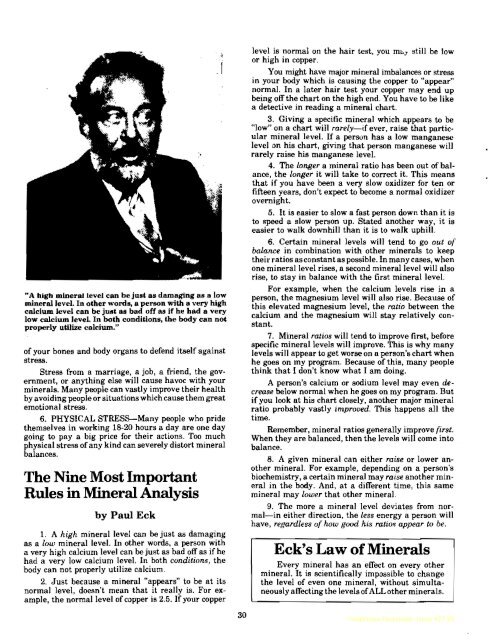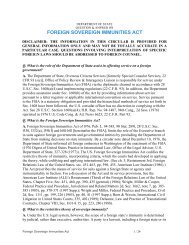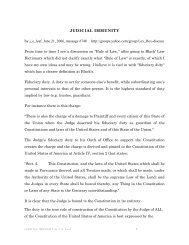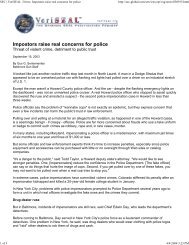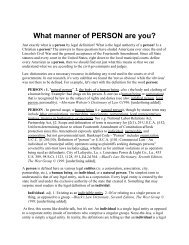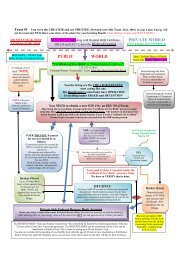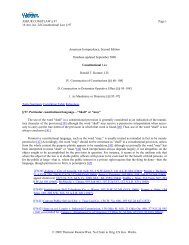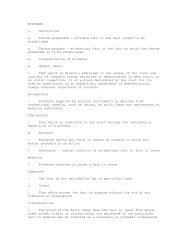The Healthview Newsletter, Issue #27-29 - Freedom School
The Healthview Newsletter, Issue #27-29 - Freedom School
The Healthview Newsletter, Issue #27-29 - Freedom School
You also want an ePaper? Increase the reach of your titles
YUMPU automatically turns print PDFs into web optimized ePapers that Google loves.
"A high mineral level can be just as damaging as a low<br />
mineral level. In other words, a person with a very hlgh<br />
calcium level can be just as bad off as if he had a very<br />
low calcium leveL In both conditions, the body can not<br />
properly utilize calcium."<br />
of your bones and body organs to defend itself against<br />
stress.<br />
Stress from a marriage, a job, a friend, the gov·<br />
ernment, or anything else will cause havoc with your<br />
minerals. Many people can vastly improve their health<br />
by avoiding people or situations which cause them great<br />
emotional stress.<br />
6. PHYSICAL STRESS-Many people who pride<br />
themselves in working 18·20 hours a day are one day<br />
going to pay a big price for their actions. Too much<br />
physical stress ofany kind can severely distort mineral<br />
balances.<br />
<strong>The</strong> Nine Most Important<br />
Rules in Mineral Analysis<br />
by Paul Eck<br />
1. A high mineral level can be just as damaging<br />
as a low mineral level. In other words, a person with<br />
a very high calcium level can be just as bad off as if he<br />
had a very low calcium level. In both conditions, the<br />
body can not properly utilize calcium.<br />
2. Just because a mineral "appears" to be at its<br />
normal level, doosn't mean that it really is. For example,<br />
the normal level of copper is 2.5. If your copper<br />
level is normal on the hair test, you m", still be low<br />
or high in copper.<br />
You might have mlijor mineral imbalances or stress<br />
in your body which is causing the copper to "appear"<br />
normal. In a later hair test your copper may end up<br />
being off the chart on the high end. You have to be like<br />
a detective in reading a mineral chart.<br />
3. Giving a specific mineral which appears to be<br />
"low" on a chart will rarely-if ever, raise that particular<br />
mineral level. If a person has a low manganese<br />
level on his chart, giving that person manganese will<br />
rarely raise his manganese level.<br />
4. <strong>The</strong> longer a mineral ratio has been out of bal·<br />
ance, the longer it will take to correct it. This means<br />
that if you have been a very slow oxidizer for ten or<br />
fifteen years, don't expect to become a normal oxidizer<br />
overnight.<br />
5. It is easier to slow a fast person down than it is<br />
to speed a slow person up. Stated another way, it is<br />
easier to walk downhill than it is to walk uphill.<br />
6. Certain mineral levels will tend to go out of<br />
balance in combination with other minerals to keep<br />
their ratios asconstant as possible. Inmany cases, when<br />
one mineral level rises, a second mineral level will also<br />
rise, to stay in balance with the first mineral leveL<br />
For example, when the calcium levels rise in a<br />
person, the magnesium level will also rise. Because of<br />
this elevated magnesium level, the ratio between the<br />
calcium and the magnesium will stay relatively constant.<br />
7. Mineral ratios will tend to improve first, before<br />
specific mineral levels will improve. This is why many<br />
levels will appear to get worse on a person's chart when<br />
he goes on my program. Because of this, many people<br />
think that I don't know what I am doing.<br />
A person's calcium or sodium level may even de·<br />
crease below normal when he goes on my program. But<br />
ifyou look at his chart closely, another major mineral<br />
ratio probably vastly Improved. This happens all the<br />
time.<br />
Remember, mineral ratios generally improve first.<br />
When they are balanced, then the levels will come into<br />
balance.<br />
8. A given mineral can either raise or lower an·<br />
other mineral. For example, depending on a person's<br />
biochemistry, a certain mineral may raise another min·<br />
eral in the body. And, at a different time, this same<br />
mineral may lower that other mineral.<br />
9. <strong>The</strong> more a mineral level deviates from nor·<br />
mal-in either direction, the less energy a person will<br />
have, regardless of how good his ratios appear to be.<br />
Eck's Law ofMinerals<br />
Every mineral has an effect on every other<br />
mineral. It is SCientifically impossible to change<br />
the level of even one mineral, without simulta·<br />
neously affecting the levels of ALL other minerals.<br />
30 <strong>Healthview</strong> Newsletetr, <strong>Issue</strong> <strong>#27</strong>-<strong>29</strong>


